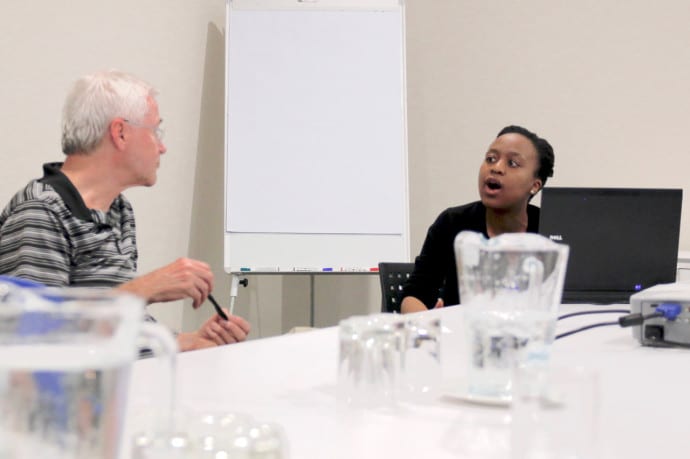“The presence of a clot can either stabilise the aneurysm, reducing the risk of rupture, or accelerate the time to rupture,” said Malebogo Ngoepe. “The key question when deciding on an appropriate intervention is when is the aneurysm likely to rupture and therefore, when should it be treated?”

Ngoepe was presenting her project entitled Comparative computational study of thrombosis in cerebral and abdominal aortic aneurysms to STIAS fellows. She is from the Department of Mechanical Engineering at the University of Cape Town and is currently an Iso Lomso fellow.
Thrombosis – clotting which causes blockage of blood vessels – is the underlying condition for many cardiovascular diseases. Clotting is also closely linked to aneurysms, which are balloon-like expansions of blood vessel walls caused by weakening of the wall layers. Aneurysms are most commonly found on blood vessels of the brain and on the aorta, and are at risk of rupture with subsequent morbidity or mortality. Clots are observed in both ruptured and unruptured aneurysms. Clots that grow in aneurysms can either assist by sealing off the aneurysm, can exacerbate the situation by speeding up the time to rupture, or can break away and cause problems elsewhere in the body.
“Aneurysms have been studied extensively by engineers because the weakening of the wall is a structural problem and the blood flow is a fluid mechanics problem. The first major project which involved engineers in this work was via the European Union-funded @neuRIST Project which started in 2006, but this didn’t include clotting,” continued Ngoepe. “So we have tools that combine structural weakness and fluid flows. But we didn’t have a way for accounting for the presence of a clot – which contributes to whether an aneurysm ruptures or stabilises.”
“Cerebral aneurysms have a prevalence of about 2 to 6% in the population,” she said. “Very few rupture but when they do they have catastrophic results.”
“More and more they are sighted accidentally when someone is being scanned for something else and the decision to treat is a difficult one considering the treatment is very invasive and they may not rupture. There is a need to know when to intervene.”
“The current treatments which involve stents, coils and flow diverters can also cause clotting and, in some cases, speed up the time to rupture.”
Ngoepe has therefore been working on a computational model which uses fluid flow and structural modelling to predict clot growth in aneurysms which will enable doctors to predict how the clot will grow and whether it’s likely to cause further damage and death.
“Clotting is about the interplay between chemistry, fluid mechanics and the vessel wall,” she continued. “So the model brings together biochemistry, mechanics and complex geometries.”
The model which Ngoepe has already developed for cerebral aneurysms (CA) is now also being directed to abdominal aortic aneurysms (AAA).
“I’m aiming to extend this model to abdominal aortic aneurysms. Such an approach will be useful for elucidating clotting features which are common and different between the pathologies. This information will be useful for disease management and therapeutic approaches.”
“Abdominal aortic aneurysms have a prevalence of about 2 to 5% and are mostly found in men over 65 years. Intervention is usually specified if the aneurysm is over 55mm in size,” said Ngoepe. “Once again, surgical or endovascular interventions are possible but 75% have some kind of related clotting.”
“Because the aorta is the main artery from the heart there is a much stronger blood flow and also a stronger pulse effect which affects protein transportation and therefore the biochemistry of the clot. The geometries of aortic aneurysms are also very different to cerebral aneurysms.”
Although there are clear differences between the two conditions Ngoepe believes they should be studied in parallel.
“The aim would therefore be to develop a computational model for AAA thrombosis similar to the one already developed for CA thrombosis. The framework would then be applied in idealised CA and AAA configurations, making it easier to draw comparisons between the two conditions.”
“Ideally you would want a patient-specific intervention pipeline which includes diagnosis of the aneurysm, comparing similar cases on an extensive database, imaging and blood tests, computational methods to predict outcome, and a proposed intervention,” she continued.
“The computational aspects include the ability to reconstruct a 3D-printed version of the blood vessels and aneurysm geometry, as well as a biochemical model which describes the patient’s clotting process based on different concentrations of proteins in the blood.”
“Ongoing model validation is also needed to ensure the model matches reality.”
However, the work is still a way away from instant desktop-accessible information in the hands of doctors.
“Currently the work requires high-performance computing. Using a laptop is possible but would take about three to four days so could only be used in non-critical cases. Ideally you would want to get this down to a reliable answer within a day. This may mean striking a balance between the level of comprehensiveness and getting a reliable result. You need a generalised model that moves towards patient specifics.”
“We also don’t yet have enough biochemical knowledge about clot maturation – in other words what might happen in six months or a year’s time – there are no models to account for that as yet,” said Ngoepe.
“The longer timeframe would have to take into account more variables, for example, the effects of other medications like antiplatelet or anticoagulant medication.”
In discussion Ngoepe was asked about using the model for deep vein thrombosis (DVT) which is a more commonly known form of thrombosis due to its links to long-distance air travel.
“My original interest was in DVTs,” she said. “I would love to take this model into work in DVTs but haven’t yet found suitable partners to work with in this area.”
Ngoepe pointed to the absolute necessity of international multidisciplinary collaboration in this work.
“Engineers, clinicians and other disciplines must work together on these challenges. We must support each other. Not doing so is catastrophic.”
